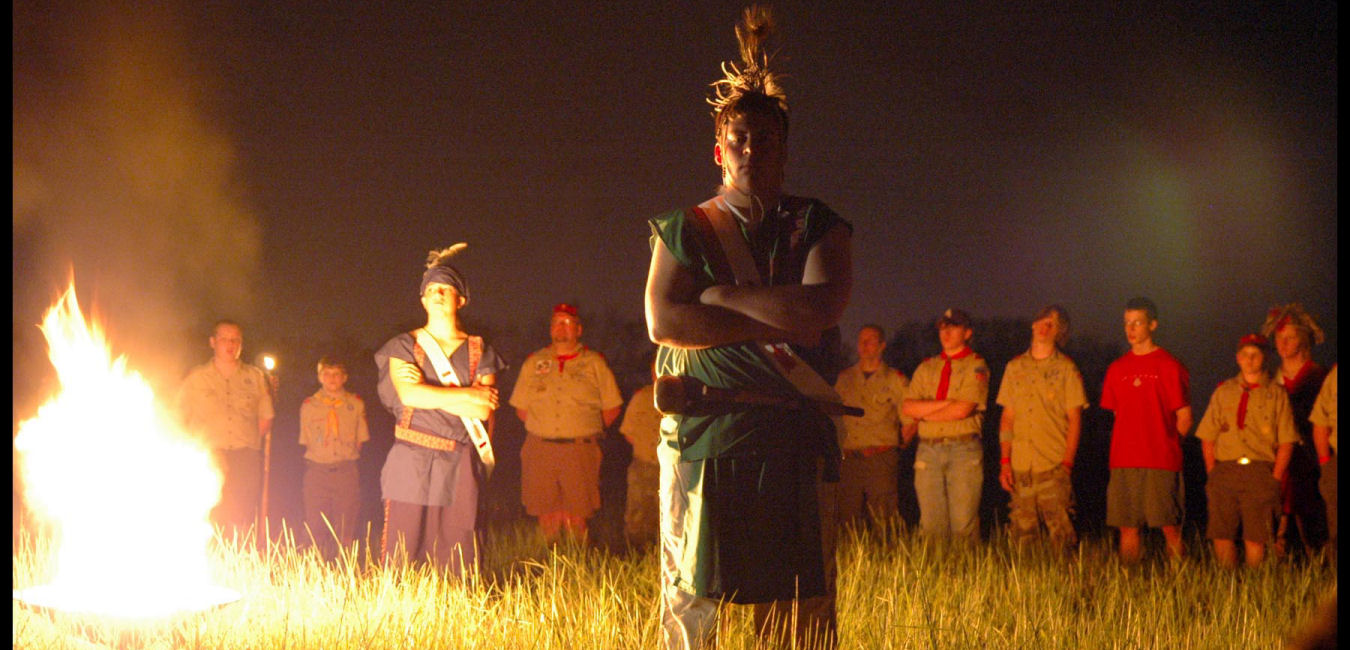
In 1915, E. Urner Goodman, a newly hired field executive for the Philadelphia Council, was assigned to serve as director of the council’s summer camp at Treasure Island Scout Reservation on the Delaware River. He believed that the summer camp experience should do more than just teach proficiency in Scoutcraft skills; rather, the principles embodied in the Scout Oath and Scout Law should become realities in the lives of Scouts. Along with his assistant camp director, Carroll A. Edson, he started an experimental program, Wimachtendienk (“Brotherhood” in the Lenape language), to recognize those Scouts best exemplifying those traits as an example to their peers.
Goodman and Edson decided that a “camp fraternity” was the way to improve the summer camp experience and to keep the older boys coming back. In developing this program they borrowed from the traditions and practices of several other organizations. Edward Cave’s Boy’s Camp Book was consulted for the concept of a camp society that would perpetuate camp traditions. College fraternities were also influential for their concepts of brotherhood and rituals, and the idea of new members pledging themselves to the new organization. Ernest Thompson Seton’s Woodcraft Indians program was also consulted for its use of American Indian lore to make the organization interesting and appealing to youth. Other influences include the Brotherhood of Andrew and Phillip, a Presbyterian church youth group with which Goodman had been involved as a young man, and Freemasonry. The traditions and rituals of the latter contributed more to the basic structure of the rituals than any other organization. In an interview with Edson during his later years, he recalled that the task of writing the first rituals of the society was assigned to an early member who was “a 32nd degree Mason.” Familiar terms such as “lodge” and “obligation,” were borrowed from Masonic practice, as were some ceremonial practices. Even the early national meeting was called a “Grand Lodge,” thought to be a Masonic reference. Goodman became a Mason only after the OA was established.
They ultimately devised a program where troops chose, at the summer camp’s conclusion, those boys from among their number who best exemplified the ideals of Scouting. Those elected were acknowledged as having displayed, in the eyes of their fellow Scouts, a spirit of unselfish service and brotherhood. Edson helped Goodman research the traditions and language of the Lenni Lenape—also known as the Delaware—who had once inhabited Treasure Island. The brotherhood of Scout honor campers with its American Indian overtones was a success and was repeated again the following summer at Treasure Island. Those Scouts honored at Treasure Island in 1915 and 1916 would eventually become members of the organization’s Unami Lodge.
By 1921, Goodman had spoken to Scout leaders in surrounding states about the honor society resulting in a number of lodges being established by Scout councils in the northeastern United States. The name of the society was changed to Order of the Arrow, and in October 1921, Goodman convened the first national meeting of what was then called the “National Lodge of the Order of the Arrow” in Philadelphia—where Goodman was elected as Grand Chieftain. Committees were organized to formulate a constitution, refine ceremonial rituals, devise insignia, and plan future development
In the early 1920s, many Scout executives were skeptical of what they called “secret camp fraternities.” By September 1922, opposition to the Order of the Arrow was such that a formal resolution opposing “camp fraternities” was proposed at a national meeting of Scout executives. Goodman argued against the motion: “Using the Scout ideals as our great objective”, he said, a camp activity that will “further the advancement of those ideals” should not be suppressed. The motion was narrowly defeated, and the fledgling Order continued as an experimental program throughout the 1920s and 1930s. In 1931, there were OA lodges in seven percent of BSA councils nationwide. By 1948, about two-thirds of the BSA councils had established OA lodges. That year also marked the time when the OA was fully integrated as an official part of the Scouting program.
Order in the 21st Century
Over the decades since the Order of the Arrow’s founding, more than one million Scouts and Scouters have worn the OA sash on their uniforms, denoting membership in the Brotherhood. There are presently approximately 180,000 members of the Order of the Arrow in all but two of BSA councils nationwide. The four stated purposes of the Order of the Arrow are: “(1) to recognize those campers—Scouts and Scouters—who best exemplify the Scout Oath and Law in their daily lives, and by such recognition cause other campers to conduct themselves in such manner as to warrant recognition; (2) to develop and maintain camping traditions and spirit; (3) to promote Scout camping, which reaches its greatest effectiveness as a part of the unit’s camping program, both year-round and in the summer camp, as directed by the camping committee of the council; and (4) to crystallize the Scout habit of helpfulness into a life purpose of leadership in cheerful service to others.”
In a new program of national service conducted from June through August 2008, the OA offered ArrowCorps5 to both youth and adult Arrowmen. Described as “one of the largest conservation efforts in Scouting’s history” by the Boy Scouts of America, approximately 3,500 Arrowmen converged on five national forests to work on various conservation projects such as building new trails and helping preserve nearly extinct species, as well as removing invasive species, in cooperation with the U.S. Forest Service. The five national forests are: Mark Twain National Forest, Manti-La Sal National Forest, George Washington and Jefferson National Forests, Shasta-Trinity National Forest and Bridger-Teton National Forest.
